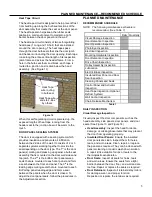
5
PLANNED MAINTENANCE
—RECOMMENDED SCHEDULE
Heat Tape Circuit
The heat tape circuit is designed to help prevent frost
from building up along the bulb seal sections of the
door assembly that create the seal w/ the door panel.
The heat tape also helps keep the rubber seals
pliable in a cold environment to maintain a tight
barrier between the door panel and the wall.
The heat tape circuit consists of two self-regulating
heat tapes (1 Long and 1 Short) that are installed
around the door opening. The heat tapes pass
through the door bulb seals that line the door jamb
and header surrounding the door opening. Each tape
runs along the entire vertical length of its respective
jamb frame and across the header frame. From a
hole in the bulb seal foam end block, each tape is
routed to a junction box located below the head
assembly. (See Figure 12)
Figure 12
When this self-regulating circuit is powered up, the
exposed lengths of heat tape running from the
header seal to the junction box will be warm to the
touch.
DOOR PANEL SEALING SYSTEM
The door is equipped with a sealing system which
provides insulation and prevents air infiltration
between the 2 sides of the wall. It consists of 2 or 3
separate systems working together to provide the
seal depending on the door type. The 1
st
is the door
panel(s) mating and pressing up against a bulb seal
assembly that is mounted on the door wall sides and
top jamb. The 2
nd
is the bottom door panel sweep
seals that are mounted to each door panel and form
a seal between the floor and panel. The 3
rd
is the
leading edge mating seals that are mounted to each
Bi-Parting panel leading edge and form a seal
between the panels when the door is closed. To
adjust the door panel seals, follow the procedures in
the Adjustments section.
PLANNED MAINTENANCE
RECOMMENDED SCHEDULE
NOTE: The following maintenance schedule is
recommended. (See Table 1)
Table 1
DAILY INSPECTION
Visual Damage Inspection
Visually inspect the door components such as the
head assembly, side panels, door panels, and door
seals. (See Figure 13 and Figure 14)
Head Assembly:
Inspect the head for dents,
damage, or missing/loose items that may prevent
the door from operating properly.
Insulated Door Panels:
Ensure the insulated
door panels are clean. Inspect them for holes,
tears, and worn areas. Clean, repair, or replace
the panels as required. They can be cleaned with
general cleaning or caustic wash down solution.
A repair kit is available for rips or tears to the
thermoplastic exoskeleton.
Door Seals:
Inspect all seals for holes, tears,
and worn areas. Ensure the seals form a tight
barrier between the door, floor, and wall and are
ice free. Repair or replace the seals as required.
Door Retainers:
Inspect all retainers/stay rollers
for damage, wear, and proper function.
Reposition or replace the retainers as required.
Daily Quarterly
Visual Damage Inspection
Door Retention Inspection
Door Operation Inspection
Photo Eye Inspection
Electrical Inspection
Mounting Hardware Inspection
Door Retention Inspection
Drive Chain Inspection
Trolley Assembly Inspection
Lubrication
Electric Brake Inspection
Insulated Door Panel and Door
Seal Inspection
Cleaning Panels and Seals
Control Panel and Activator
Inspection
Heat Tape Inspection (Optional
Defrost System)
Wall Anchor Inspection
Chain Release Mechanism
Heat Tape
wire routing
in bulb seal
Heat Tape wire
ends to J-Box
by others
Содержание Turbo-Slide
Страница 2: ......
Страница 8: ......
Страница 29: ...21 NOTES...
Страница 32: ...PARTS LIST BI PARTING DOOR ASSEMBLY 24 BI PARTING DOOR ASSEMBLY Figure 48 1 2 3 4 6 7 8 9 10 Bi Parting Door 5...














































